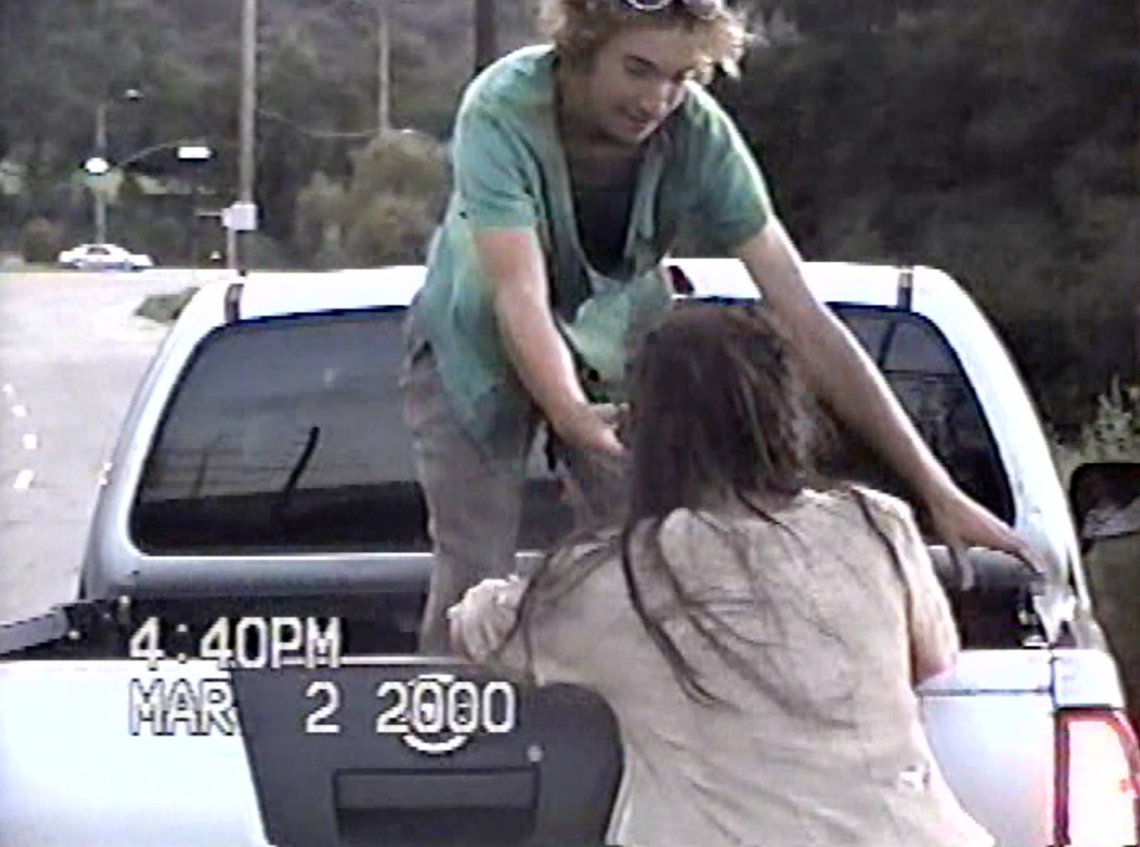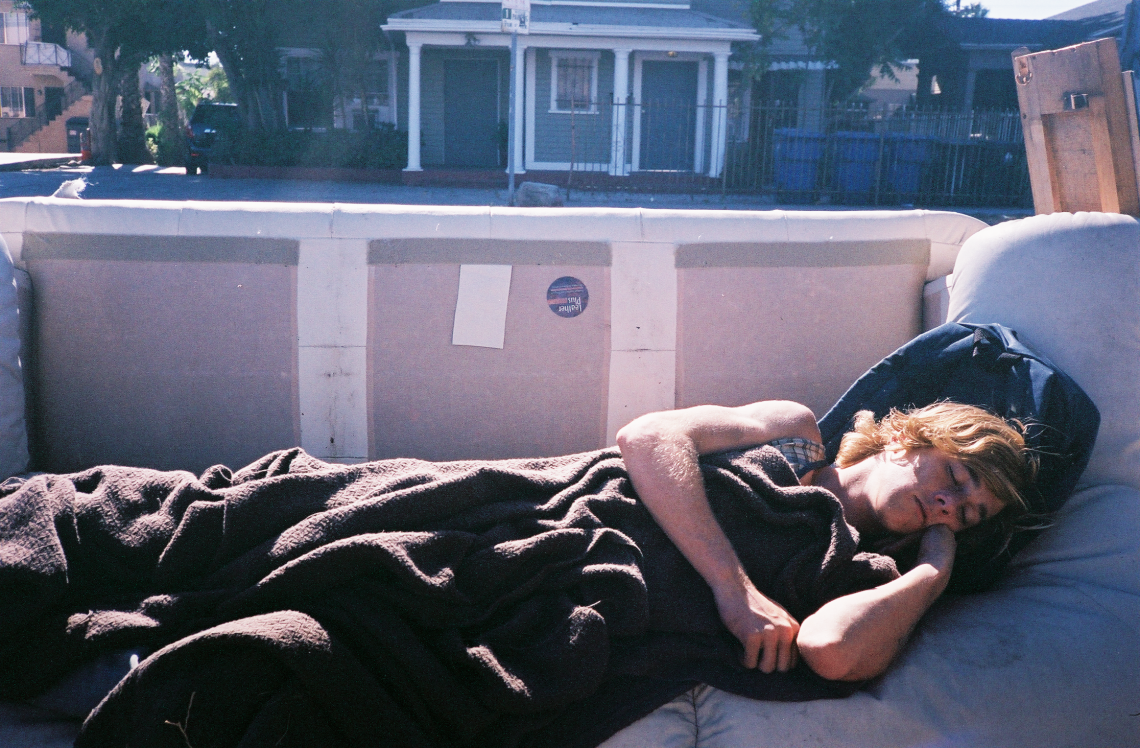Self-taught Danish filmmaker Ada Bligaard Søby makes films infused with a sense of exploration and movement. One of her most recent productions is the music video “Hitchhiker,” set to Parisian trio Tristesse Contemporaines I Didnt Know. For this film, Søby was shortlisted for the 2015 Cannes Lions Young Director Award.
Filmed with a VHS camera and mixing contemporary and vintage aesthetics, “Hitchhiker” follows homeless adolescents on the move through the desert and urban wastelands. The film conveys a sense of deep roadside wanderlust that echoes Søbys own early years of not really having a direction except adventure.
Born in Denmark and raised by historians in a sixteenth-century castle north of Copenhagen, Søby has worked on a variety of projects, from fashion photography to documentary films and art installations. She has been nominated for a number of awards, and her films have been featured at the Rotterdam International Film Festival and the New York Video Festival, among others.
In her interview with Lola Who, Søby discusses the production of Hitchhiker, what travel means for her, and an upcoming creative project.
Lola Who: Please tell us a little bit about yourself, your background, and how you got started with filmmaking?
Ada: I never went to school for filmmaking, but I have taught filmmaking in schools, and I dont recommend going to school for anyone who wants to be a filmmaker. I think I just started to move away from everything I knew when I was really young. I moved to Canada when I was 16, and to New York when I was 20, both times alone. So I experienced the world in a very unsupervised and authentic way. I didnt really have a direction except adventure, and I think that’s a good foundation for any storyteller. I also learned to hustle quite early and make things happen without support and that also turned out to be a good thing.

Lola Who: What is the artistic process like for you when you work on making videos?
Ada: Usually I dont make music videos because the budgets are small, and the good songs are few and Im extremely picky. But I have made videos for people without telling them, just out of love for a particular track. Then, I just make it and send it to them and say: “Hey, I made a video for you.” I did that for Total Control, an Australian band, and it consists of footage from an 80s documentary about the German autobahn. The energy of the footage and the intensity of the song is just the perfect violent match.
Lola Who: What do you read, listen to, or look at to deepen your work and find inspiration?
Ada: Hanging out with friends and having a common understanding that the world is a bloody messy circus where youve got to embrace the chaos. This is a good way to step outside the confining norms of society and see everything in a new light. And then you see inspiration pretty much everywhere.

Lola Who: How big was the production crew for Hitchhiker?
Ada: It was small but tight. My best friend Brian Lee Hughestop director and owner of L.A. gallery SADEfacilitated the first meeting I had with the very young producer Ryan Curtis, who had recently moved to L.A. from the state of Georgia. So our first meeting was last August, in Brians house in Silverlake, and Ryan and I had been talking for a couple of hours about the project in a very mature and serious manner, when Brian appeared out of his bedroom. He had just woken up from a jet-lagged sleep, and he had a bottle of Makers Mark in one hand while he was scratching his balls in his red underwear with the other. He announced to the young producer: “kid, you’ve made it.” You are in an elevated house in L.A. producing videos for an award-winning director.
Lola Who: How did you interact with the performer in Hitchhiker to define the story and the visual ambiance?
Ada: I just sat there and spoke to them and said things like: “this is a friendship story, not a love story, and I think that the world is ending, and we have to show that somehow.” I just said things like that.

Lola Who: What was the biggest challenge that you faced in creating Hitchhiker?
Ada: It didnt feel that “Hitchhiker” was more challenging than any other film production I’ve been on, but there was a challenge regarding the cops, because in L.A. you’re not supposed to hang out at a freeway entrance ramp with a VHS camera and a bunch of kids in rags. But Angel, the girl with the missing arm, told us that cops usually act protectively towards her. And she was like: “And how are they going to handcuff me anyway?”
Lola Who: When working on Hitchhiker, what came first; the music or the film?
Ada: I made the video and then I started looking for the right song. But my editor, Olivia, and I needed a track to edit to, and we just fell in love with the song “I Did’nt Know” from Tristesse Contemporaine. I contacted the band, and they agreed to let me use it, as they liked the footage and the combination.
Lola Who: What do you want your viewers to take away from Hitchhiker?
Ada: I just want the public to feel the heat and the sweat, and the saliva and the abandoned erotica going on. Mostly, I want viewers to feel the friction between the dog being tied up in the bathroom and the kids out on the streets, and maybe think about which one of them their life reflects the most?
Lola Who: You have filmed documentaries and films all over the world, and Hitchhiker conveys a sense of wanderlust. What does travel mean to you?
Ada: I love to be on the move and in strange places where I dont quite know the codes and the laws but have to figure it out and meet people on a very human level like on their terms, not mine.

Lola Who: What is your dream project?
Ada: Something that is both intelligent and seductive, which includes both pop culture icons, social awareness, humor, and sex. Kate Moss being a lonely crazy cat lady on a mountain with dead trees, mixed with footage commenting on all the refugees in their unsafe boats trying to enter Europe, mixed with someone trying to open a locked door with a fish net, mixed with a drunk weather reporter foreseeing some dark storms. I dont care too much about format or length, or if it’s called cinema, art, commercial, music video or collage, but I do need a budget.
Lola Who: Is there something you are currently working on, or are excited about starting that you can tell us about?
Ada: Im working on a book with my French ex-boyfriend, a book of our personal photographs. Im very excited about it because it’s such a weird project and it’s so intimate. I hope we get permission from all the people in the pictures, which includes our parents, Hitler and Nina Hagen. I hope we dont make people sad, but make them laugh instead.

